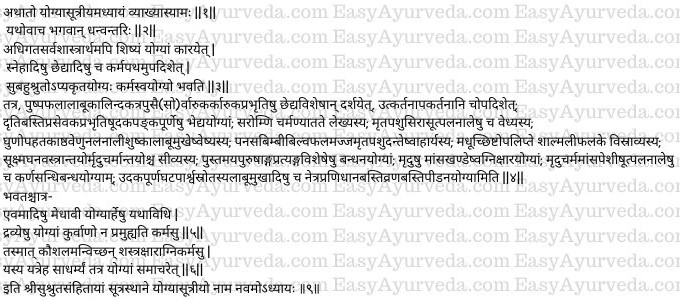This article explains Sushruta Samhita Sutrasthana Chapter 9 “Yogyasutriya Adhyaya”- Imparting Practical training.
Yogyasutriya Adhyaya
We shall now explain the chapter by name Yogyasutriya- making the student fit (for surgical work) as revealed by venerable Dhanvantri.
Read – Methods Of Surgical Training Elaborated In Ayurveda
Karmabhayasa Mahatva
Important of practical training
In spite of the student having studied and understood the meanings (implications) of the science fully (after completing the study) he should be made a Yogya (fit person – expert in practical training). He should be instructed in the practical methods of medical therapies including oleation, sudation etc. and surgical therapies like excising etc. In spite of being well read (and equipped with good theoretical knowledge), he becomes unfit (incompliant for surgical activities) if he is not made yogya – well equipped and well trained in practical training.
Read – Foreign Body Removal – Ashtanga Hrudaya Sutrasthana 28
Sanskrit Verses

Karmabhyasa
Practical training
Note – The physician should demonstrate the surgical methods using many materials mentioned below in the context of each procedure. The students shall practice those procedures voluntarily (after being trained thoroughly) on the same dummies.
Chedana (excision) – Different kinds of Chedana (excising / removal after separating) should be demonstrated by using puspa phala (Kusmanda), Alabu, Kalindaka, Trapusa, Ervaruka, etc. Utkartana (excess cutting / upward excision), and Parikartana (inadequate cutting / downward excision) should also be demonstrated and practiced on the same materials.
Bhedana (splitting, dividing) – Splitting and dividing procedures should be demonstrated on (and practiced on) the bellows, urinary bladder (of animals), leather sac and such others filled with water or slush.
Lekhana (scraping / scarification) – Scraping procedures should be demonstrated (and practiced on) by using a broad sheet of leather with hairs.
Vedhana (puncturing) – Puncturing should be demonstrated on (by using) the veins of dead animals and stalks of lily plant.
Esana (probing, exploring) – Probing should be demonstrated (and practised) by using the holes in pieces of wood eaten by moths, bamboo, Nala (a kind of hollow reed) and dry Alabu (pitcher gourd).
Aharana (extracting / pulling out) – Extraction should be demonstrated (and practiced) on the fleshy portion of Panasa, Bimbi, Bilva phala, and teeth of dead animals.
Visravana (draining fluids) – Draining should be demonstrated (and practiced) by using planks of Salmali wood smeared with beeswax.
Seevana (suturing, sewing, joining) – Suturing is demonstrated (and practiced) by using thin and thick cloth (their edges are sutured together) or soft skin (leather).
Bandhana (bandaging) – Different kinds of bandaging is demonstrated (and practiced) on models of parts of the human body prepared from mud cloth etc. i.e., dummies.
Agnikarma (applications of fire branding / thermal cauterization) and Ksarakarma (Alkaline cauteries) – Both types of cautery i.e., fire and alkali cauterization should be demonstrated (and practiced) on soft muscles.
Karnasandhibandhana (fabricating the ear) – Joining the severed ear should be demonstrated (and practiced) on soft skin, smooth muscles and hollow stalk of lily plant.
Vasti Karma (enema) and Vrana Vasti Karma ((washing the wounds, ulcers) – Enema and wound wash should be demonstrated (and practiced) by inserting a tube / spout (beak) into an orifice made on the side of the pot containing water or into the orifice (mouth, opening) made in the mouth of the alabu (pitcher gourd).
Read – Sushruta’s 8 Types Of Surgical Procedures – Astavidha Shastra Karma
A Verse here: –
In this manner, the intelligent (student) who has been made fit i.e., practically trained by the use of things which are suitable for practical training, as described in the science, does not falter in his actions.
Hence, he who desires skill (expertise) in the use of sharp instruments, alkaline and thermal cautery etc. should make use of objects similar (suitable) to the act and become fit (skilled in surgical work).
Notes: – What we have to appreciate from the foregoing description is the utmost importance our ancient teachers had given to practical training in surgical activities, their ingenuity in selection of commonly used things and artificially prepared models suitable for each technique and their effort to make every student fit to perform all surgical activities.
Thus ends the Ninth chapter by name Yogyasutriya, in Sutra Sthana of Susruta Samhita.


